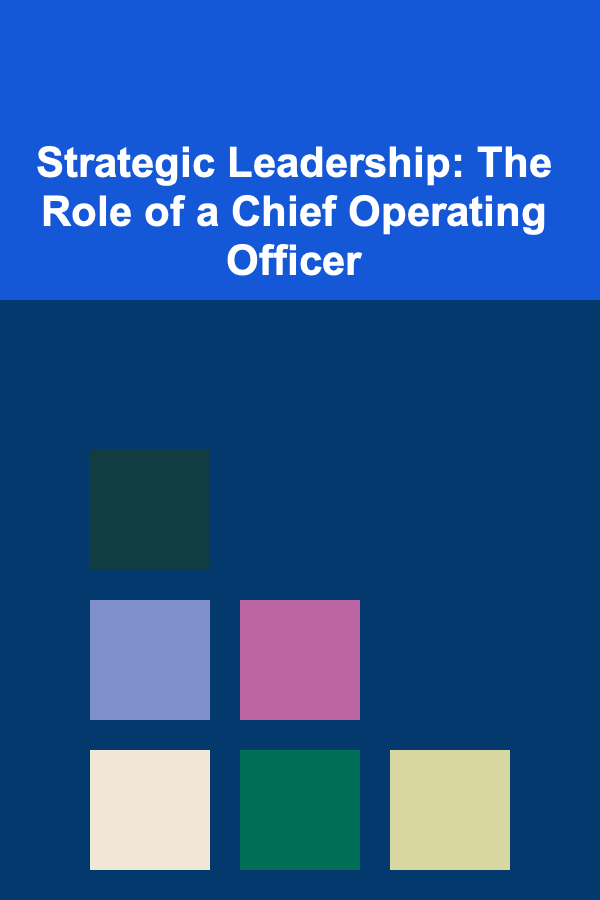
Strategic Leadership: The Role of a Chief Operating Officer
ebook include PDF & Audio bundle (Micro Guide)
$12.99$11.99
Limited Time Offer! Order within the next:

The Chief Operating Officer (COO) has traditionally been seen as the individual responsible for ensuring smooth operations within an organization. While that role remains important, the modern COO is now expected to be much more than a caretaker of daily processes. In today's competitive business environment, the COO has emerged as a key strategic leader, driving operational excellence, fostering innovation, and ensuring the company can pivot quickly to adapt to new opportunities or challenges.
This guide explores the multifaceted role of the COO, emphasizing their strategic leadership in shaping the direction of the organization, implementing operational strategies, and delivering long-term value.
The Evolving Role of the COO
Historically, the COO was primarily responsible for overseeing the organization's internal operations, ensuring efficiency, and optimizing productivity. Today, however, the role has expanded, and COOs are often seen as second-in-command, working closely with the CEO to execute the company's vision and long-term strategy.
From Operational Manager to Strategic Partner
The most significant shift in the COO's role is the increasing expectation to participate in the creation and execution of the company's strategy. Rather than merely managing day-to-day operations, COOs are now tasked with developing strategies that will enable the organization to grow, compete, and thrive in a rapidly evolving business environment.
Actionable Steps:
- Align Operations with Strategic Goals: The COO must have a deep understanding of the organization's overall strategy and ensure that operational efforts support these objectives. This requires a clear connection between long-term goals and day-to-day activities.
- Bridge the Gap Between Leadership and Operations: COOs must collaborate closely with the CEO, CFO, and other executives to ensure the strategic direction is effectively translated into actionable plans at all levels of the organization.
- Be a Change Agent: As organizations face disruptions from technological advancements, economic shifts, and changing consumer preferences, the COO must be proactive in anticipating and managing change. They should lead efforts to streamline operations, adapt business models, and ensure organizational agility.
Strategic Leadership and Operational Excellence
The COO's strategic leadership is grounded in the ability to align operational execution with the company's long-term goals. This includes creating systems, structures, and processes that not only maintain current operational standards but also position the company for sustainable growth.
Setting the Operational Strategy
The strategic role of the COO goes beyond implementing existing strategies; it includes shaping them. Effective COOs must ensure that operational goals are not only efficient but also forward-thinking, supporting innovation, scaling operations, and positioning the company for future success.
Actionable Steps:
- Develop Scalable Systems: COOs should prioritize building operational systems that can scale with the growth of the business. This might involve investing in technology platforms, process automation, and data management solutions to handle increasing volumes of transactions or more complex customer demands.
- Optimize Resource Allocation: A key component of operational strategy is ensuring resources---both human and capital---are allocated efficiently to high-priority areas that align with the company's strategic objectives.
- Promote Cross-Functional Collaboration: To ensure operational success, COOs must promote communication and collaboration across departments. This involves breaking down silos and fostering a collaborative environment where different functions (e.g., HR, marketing, finance, IT) work together to achieve the company's strategic vision.
Leveraging Data for Decision Making
In the age of big data, the ability to make data-driven decisions is an essential skill for any strategic leader. COOs must harness the power of data analytics to refine operational strategies, improve efficiency, and monitor key performance indicators (KPIs) across the organization.
Actionable Steps:
- Implement Business Intelligence Tools: COOs should champion the integration of business intelligence (BI) tools like Tableau, Power BI, or Google Analytics into the company's operations. These tools provide real-time insights that enable data-driven decision-making and help identify areas for operational improvement.
- Monitor Key Metrics: The COO should work with other executives to define critical operational metrics (e.g., customer satisfaction, operational costs, production efficiency) and continuously monitor them. Regular performance reviews using these metrics will help the company stay on course and adapt strategies when necessary.
- Leverage Predictive Analytics: Beyond monitoring past performance, COOs should use predictive analytics to forecast future trends and outcomes. Whether it's anticipating demand, understanding market shifts, or predicting employee turnover, predictive analytics can help the COO steer the organization in the right direction.
Fostering a Culture of Innovation and Agility
Strategic leadership is not only about operational efficiency but also about driving innovation. Today's business leaders must create organizations that are agile, adaptable, and open to new ideas and approaches. The COO plays a crucial role in shaping and sustaining a culture of innovation.
Encouraging Innovation Across the Organization
Innovation is often associated with product development or R&D, but it is just as important in operations, customer service, marketing, and HR. The COO should encourage innovation across all areas of the organization, ensuring that new ideas are encouraged, tested, and implemented to improve both internal operations and the customer experience.
Actionable Steps:
- Create Innovation Platforms: COOs should establish formalized platforms or channels where employees can submit and discuss new ideas. These can include hackathons, idea challenges, or innovation labs that encourage creative problem-solving and idea generation.
- Promote a Risk-Tolerant Culture: Innovation often involves taking risks, and the COO should work to foster an environment where calculated risks are encouraged and where failure is seen as part of the learning process.
- Use Technology to Enable Innovation: COOs can leverage emerging technologies such as AI, automation, and machine learning to streamline operations, enhance decision-making, and uncover new business opportunities.
Promoting Organizational Agility
Agility is the ability to pivot quickly in response to changes in the market, customer needs, or industry trends. In today's fast-paced business environment, organizational agility is a competitive advantage, and the COO plays a key role in ensuring that the organization remains flexible and responsive.
Actionable Steps:
- Adopt Agile Methodologies: While agile methodologies are commonly associated with software development, they can be applied to other business areas as well. COOs should introduce agile principles to non-technical teams and departments, helping them become more adaptable to changes.
- Empower Teams to Make Decisions: COOs should decentralize decision-making to enable teams to act quickly in response to customer feedback or market changes. This requires empowering employees at all levels to make decisions within defined frameworks or guidelines.
- Continuous Process Improvement: The COO should champion continuous improvement initiatives, regularly reviewing and refining business processes to enhance efficiency, reduce costs, and improve customer satisfaction. This includes using Lean and Six Sigma methodologies to identify inefficiencies and eliminate waste.
Navigating Complex Business Challenges
In addition to their internal leadership responsibilities, COOs often play a key role in managing external challenges that impact the organization. These challenges could be related to supply chain disruptions, changing regulatory landscapes, competitive pressures, or shifts in customer behavior. A strategic COO must be able to anticipate, identify, and navigate these external challenges while ensuring the company remains focused on its long-term vision.
Crisis Management and Risk Mitigation
During periods of crisis, the COO must lead with decisiveness, ensuring that the organization can respond quickly and effectively. This includes mitigating risks and implementing contingency plans to minimize the impact of disruptions on operations.
Actionable Steps:
- Develop Contingency Plans: The COO should work with other senior leaders to develop and maintain contingency plans for a variety of potential scenarios, including supply chain disruptions, economic downturns, or cyberattacks.
- Risk Assessment and Mitigation: Strategic COOs regularly assess operational risks, from financial vulnerabilities to technological weaknesses. They should implement risk mitigation strategies, such as diversifying suppliers, strengthening IT security, and building financial buffers.
- Effective Communication: During a crisis, the COO must communicate clearly and consistently with all stakeholders, including employees, customers, and investors. Transparent communication helps build trust and ensures that everyone understands the company's actions and objectives.
Leading Organizational Change
As organizations grow, they often go through significant changes---whether it's expanding into new markets, integrating acquisitions, or restructuring operations. The COO plays a critical role in leading these changes, ensuring that they are executed smoothly and that employees are supported throughout the transition.
Actionable Steps:
- Champion Change Initiatives: COOs should lead change management efforts by helping the organization embrace transformation and overcome resistance to change. This can include introducing new tools, technologies, or ways of working.
- Provide Training and Support: Effective change requires adequate training and support for employees. The COO should ensure that employees are equipped with the skills and resources they need to adapt to new systems and processes.
- Measure and Refine the Change Process: As changes are implemented, the COO must monitor progress and gather feedback from employees and other stakeholders. This feedback can be used to refine the change process and ensure its success.
Conclusion
The role of the COO has evolved from a tactical operations manager to a strategic leader who shapes the direction of the organization. By aligning operational strategies with long-term goals, fostering innovation, and ensuring the organization remains agile, COOs play a critical role in driving the success of the business.
Strategic leadership is about more than just managing processes---it's about anticipating change, empowering teams, and navigating challenges. As organizations face increasing complexity and uncertainty, the COO's ability to lead with foresight and flexibility will be instrumental in ensuring sustained growth and long-term success. The modern COO is not just a manager; they are a visionary leader who drives transformation and creates lasting value for the company.

How to Encourage Community Engagement in Home Safety
Read More
How to Plan for Big Purchases Without Breaking the Bank
Read More
How to Refresh Your Home's Curb Appeal with Simple Changes
Read More
How to Stage Your Home to Sell as a Luxury Property
Read More
How to Prepare Flavorful Vegan Meals
Read More
How to Make Wine from Wild Berries
Read MoreOther Products

How to Encourage Community Engagement in Home Safety
Read More
How to Plan for Big Purchases Without Breaking the Bank
Read More
How to Refresh Your Home's Curb Appeal with Simple Changes
Read More
How to Stage Your Home to Sell as a Luxury Property
Read More
How to Prepare Flavorful Vegan Meals
Read More